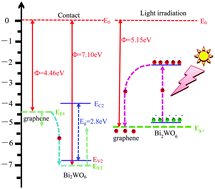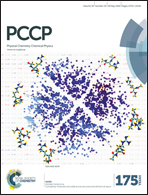A graphene-coupled Bi2WO6 nanocomposite with enhanced photocatalytic performance: a first-principles study
Abstract
An experimentally synthesized graphene/Bi2WO6 composite showed an enhancement of the visible-light photocatalytic activity, while the underlying mechanism is not known. Here, first-principles calculations based on density functional theory were performed to explore the various properties of the graphene/Bi2WO6(010) composite aiming at gaining insights into the mechanism of its photocatalytic activity. The stability, electronic properties, charge transfer, and visible-light response were investigated in detail on the Bi2WO6(010) surface coupled with graphene. An analysis of charge distribution and Bader charge shows that there is a strong covalent bonding between graphene and the Bi2WO6(010) surface. The covalent interaction induces a small bandgap in graphene. The interband transition of graphene and the surface states of the Bi2WO6(010) surface would cause the absorption spectrum of graphene/Bi2WO6(010) to cover the entire visible-light region and even the infrared-light region. The photogenerated electrons flow to graphene from the conduction band of Bi2WO6 under the built-in electric field and band edge potential well. Thus, graphene serves as a photogenerated electron collector and transporter which significantly reduces the probability of electron–hole recombination and increases catalytic reaction sites not only on the surface of graphene but on also the surface of Bi2WO6. The decrease of charge recombination is possibly responsible for the enhancement of the visible-light photocatalytic activity of the graphene/Bi2WO6(010) nanocomposite.


 Please wait while we load your content...
Please wait while we load your content...